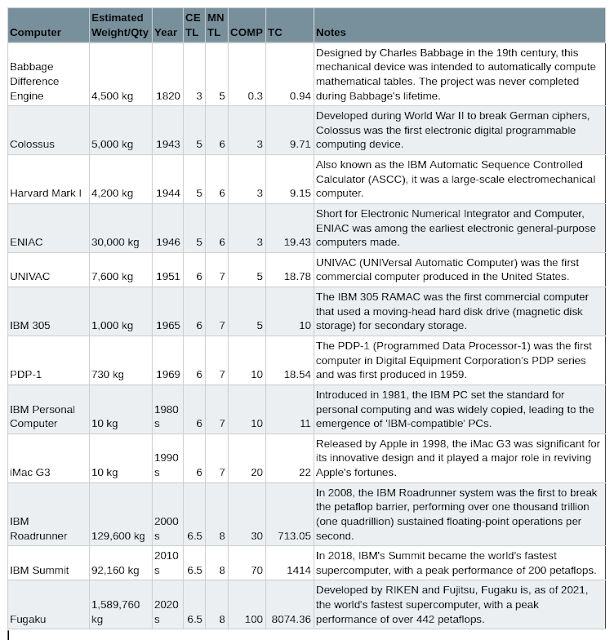Computers and Software and the Mneme variant, along with the definition of Compute:
Compute: In this game’s context, Compute represents a computer system’s abstract computational power. It’s a measure of the system’s ability to process data, run programs, and perform tasks. The Compute value is determined by the Tech Level (TL), with each TL representing a significant leap in computational capabilities. For example, a Compute value of 1 represents the computational power of a human computer from the 1940s, while a Compute value of 10 represents a modern-day computer.
In the original CE, there’s an inconsistency between the Equipment and Ships chapters regarding the representation of computer power. The Equipment chapter uses Models (CE SRD page 70) while the Ships chapter switches to Ratings (CE SRD p127). In the Mneme variant, we’ve chosen to stick with Ratings for consistency.
The original CE also represents computer power in a linear fashion across TLs, which doesn’t accurately reflect the exponential growth of computing power observed in reality (as predicted by Moore’s Law). In the Mneme variant, we’ve adjusted this to an exponential scale to more accurately represent the rapid advancements in computing technology.
In terms of accessibility, the Mneme variant acknowledges the socio-economic barriers to advanced computing technology. Regular computers become prohibitively expensive as we move into higher TLs (TL9 and beyond, which represent the Sci-Fi age in Traveller and GURPS). This reflects the current reality where advanced computing devices (like AI systems) are beyond the financial reach of many individuals and organizations*. To balance this, cheaper and smaller computers with diminished computing power become more prevalent.
In the Mneme setting, it’s assumed that socio-economic levels (SOC) may be stuck longer in certain TLs. For example, in the default setting similar to the Interstellar Wars in 2400s Common Era (which is TL13), 90% of Sol’an (humans from Sol) are using TL9 to TL10 technology with small advanced components. This reflects the reality that not all individuals or societies have equal access to advanced technology.
The Computer Example table provides a reference for what computers of different Compute values are capable of. This table can be used to resolve brute force attacks, computer-aided design and task resolution, and other tasks that rely on computing power. It’s important to think hard about the implications of AI and more powerful AIs, and how they fit into the setting, while also acknowledging their hard limitations.
This booklet is intended to provide players and GMs with the tools they need to understand and utilize the Compute concept in the game, even though it’s out of scope regarding the Ship Combat Book.
*NOTE.
I’m building our Lab in the Comfac Technology Center the difference between me and the student is that I have the income to buy the equipment to learn to use it. Regular students and most IT staff don’t have the money to have equipment for hands-on experience and training. Recently we’ve been giving access to students to our GCP account, hands-on on using PFsense Firewalls (We have 4 pfsense firewalls they can practice with ) and Network Equipment (access points, mesh, media converters etc… as well as cabing equipment). The challenge of learning System Admin is the need to have an extra Computer for Experiments to get hands-on Training, with network you need a Computer and Another Subnetwork to Learn. I’m also an Open source advocate and teach, in an open source manner sharing our notes freely. I really feel the SOC disadvantage, especially when I know my SOC income in developed world and I have to pay out of pocket for these (hoping one day I can use the Company credit card and get the tax credits for spending 5 to 10k USD on such equipment which is necessary for our LLM lab.



Leave a Reply
You must be logged in to post a comment.